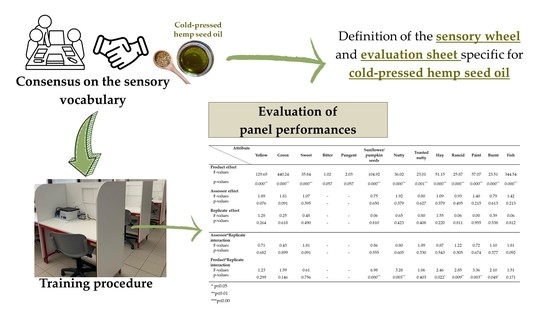Sensory Wheel and Lexicon for the Description of Cold-Pressed Hemp Seed Oil
Abstract
1. Introduction
2. Materials and Methods
2.1. Samples
2.2. Panel Selection
2.3. Consensus on the Sensory Vocabulary
2.4. Evaluation Sheet
2.5. Training Procedure
2.6. Data Analysis
3. Results
3.1. Descriptors of Sensory Properties of CP-HSO
3.2. Profile Sheet for CP-HSO Tasting
3.3. Evaluation of Panel Performances
4. Discussion
5. Conclusions
Author Contributions
Funding
Informed Consent Statement
Data Availability Statement
Acknowledgments
Conflicts of Interest
References
- Chew, S.C. Cold-Pressed Rapeseed (Brassica Napus) Oil: Chemistry and Functionality. Food Res. Int. 2020, 131, 108997. [Google Scholar] [CrossRef]
- Kotecka-Majchrzak, K.; Sumara, A.; Fornal, E.; Montowska, M. Identification of Species-Specific Peptide Markers in Cold-Pressed Oils. Sci. Rep. 2020, 10, 19971. [Google Scholar] [CrossRef]
- CODEX STAN 193-1995; Codex Standard for Named Vegetable Oils. Food and Agriculture Organization: Rome, Italy, 2011.
- Gaca, A.; Kludská, E.; Hradecký, J.; Hajšlová, J.; Jeleń, H.H. Changes in Volatile Compound Profiles in Cold-Pressed Oils Obtained from Various Seeds during Accelerated Storage. Molecules 2021, 26, 285. [Google Scholar] [CrossRef]
- Commission Regulation (EU). 2022/1393, No. 2022/1393 of 11 August 2022 amending Regulation (EC) No 1881/2006 as regards maximum levels of delta-9-tetrahydrocannabinol (Δ9-THC) in hemp seeds and products derived therefrom. Off. J. Eur. Union 2022, 211, 83–85.
- Liang, J.; Aachary, A.A.; Hydamaka, A.; Eskin, N.A.M.; Eck, P.; Thiyam-Holländer, U. Reduction of Chlorophyll in Cold-Pressed Hemp (Cannabis sativa) Seed Oil by Ultrasonic Bleaching and Enhancement of Oxidative Stability. Eur. J. Lipid Sci. Technol. 2018, 120, 1700349. [Google Scholar] [CrossRef]
- Siudem, P.; Wawer, I.; Paradowska, K. Rapid Evaluation of Edible Hemp Oil Quality Using NMR and FT-IR Spectroscopy. J. Mol. Struct. 2019, 1177, 204–208. [Google Scholar] [CrossRef]
- Izzo, L.; Pacifico, S.; Piccolella, S.; Castaldo, L.; Narváez, A.; Grosso, M.; Ritieni, A. Chemical Analysis of Minor Bioactive Components and Cannabidiolic Acid in Commercial Hemp Seed Oil. Molecules 2020, 25, 3710. [Google Scholar] [CrossRef]
- Teh, S.S.; Birch, J. Physicochemical and Quality Characteristics of Cold-Pressed Hemp, Flax and Canola Seed Oils. J. Food Compos. Anal. 2013, 30, 26–31. [Google Scholar] [CrossRef]
- Micalizzi, G.; Vento, F.; Alibrando, F.; Donnarumma, D.; Dugo, P.; Mondello, L. Cannabis sativa, L.: A Comprehensive Review on the Analytical Methodologies for Cannabinoids and Terpenes Characterization. J. Chromatogr. A 2021, 1637, 461864. [Google Scholar] [CrossRef]
- Genovese, A.; Caporaso, N.; Leone, T.; Paduano, A.; Mena, C.; Perez-Jimenez, M.A.; Sacchi, R. Use of Odorant Series for Extra Virgin Olive Oil Aroma Characterisation. J. Sci. Food Agric. 2019, 99, 1215–1224. [Google Scholar] [CrossRef]
- Larssen, W.E.; Monteleone, E.; Hersleth, M. Sensory Description of Marine Oils through Development of a Sensory Wheel and Vocabulary. Food Res. Int. 2018, 106, 45–53. [Google Scholar] [CrossRef]
- Piochi, M.; Cabrino, G.; Torri, L. Check-All-That-Apply (Cata) Test to Investigate the Consumers’ Perception of Olive Oil Sensory Properties: Effect of Storage Time and Packaging Material. Foods 2021, 10, 1551. [Google Scholar] [CrossRef]
- Matthäus, B.; Brühl, L. Virgin Hemp Seed Oil: An Interesting Niche Product. Eur. J. Lipid Sci. Technol. 2008, 110, 655–661. [Google Scholar] [CrossRef]
- Citti, C.; Pacchetti, B.; Vandelli, M.A.; Forni, F.; Cannazza, G. Analysis of Cannabinoids in Commercial Hemp Seed Oil and Decarboxylation Kinetics Studies of Cannabidiolic Acid (CBDA). J. Pharm. Biomed. Anal. 2018, 149, 532–540. [Google Scholar] [CrossRef]
- Sova, N.; Lutsenko, M.; Korchmaryova, A.; Andrusevych, K. Research of Physical and Chemical Parameters of the Oil Obtained from Organic and Conversion Hemp Seeds Varieties “Hliana”. Ukr. Food J. 2018, 7, 244–252. [Google Scholar] [CrossRef]
- Krist, S. Hempseed Oil. In Vegetable Fats and Oils; Springer: Berlin/Heidelberg, Germany, 2020; pp. 353–359. [Google Scholar] [CrossRef]
- Cerino, P.; Buonerba, C.; Cannazza, G.; D’Auria, J.; Ottoni, E.; Fulgione, A.; Di Stasio, A.; Pierri, B.; Gallo, A. A Review of Hemp as Food and Nutritional Supplement. Cannabis Cannabinoid Res. 2021, 6, 19–27. [Google Scholar] [CrossRef]
- Soroush, D.R.; Solaimanimehr, S.; Azizkhani, M.; Kenari, R.E.; Dehghan, B.; Mohammadi, G.; Sadeghi, E. Optimization of Microwave-Assisted Solvent Extraction of Hemp (Cannabis sativa L.) Seed Oil Using RSM: Evaluation of Oil Quality. J. Food Meas. Charact. 2021, 15, 5191–5202. [Google Scholar] [CrossRef]
- Dinnella, C.; Pierguidi, L.; Spinelli, S.; Borgogno, M.; Gallina Toschi, T.; Predieri, S.; Lavezzi, G.; Trapani, F.; Tura, M.; Magli, M.; et al. Remote Testing: Sensory Test during Covid-19 Pandemic and Beyond. Food Qual. Prefer. 2022, 96, 104437. [Google Scholar] [CrossRef]
- Rabitti, N.S.; Cattaneo, C.; Appiani, M.; Proserpio, C.; Laureati, M. Describing the Sensory Complexity of Italian Wines: Application of the Rate-All-That-Apply (RATA) Method. Foods 2022, 11, 2417. [Google Scholar] [CrossRef]
- Pehlivan, B.; Yılmaz, E. Comparison of Oils Originating from Olive Fruit by Different Production Systems. JAOCS J. Am. Oil Chem. Soc. 2010, 87, 865–875. [Google Scholar] [CrossRef]
- Bendini, A.; Barbieri, S.; Valli, E.; Buchecker, K.; Canavari, M.; Toschi, T.G. Quality Evaluation of Cold Pressed Sunflower Oils by Sensory and Chemical Analysis. Eur. J. Lipid Sci. Technol. 2011, 113, 1375–1384. [Google Scholar] [CrossRef]
- Cortés-Diéguez, S.; Otero-Cerviño, C.; Rodeiro-Mougán, H.; Feijóo-Mateo, J.A. Quantitative Descriptive Analysis of Traditional Herbal and Coffee Liqueurs Made with Grape Marc Spirit (Orujo). Foods 2020, 9, 753. [Google Scholar] [CrossRef]
- Gomis-Bellmunt, A.; Claret, A.; Puig-Pujol, A.; Pérez-Elortondo, F.J.; Guerrero, L. Development of a Descriptive Profile and References for the Assessment of Taste and Mouthfeel Descriptors of Protected Designation of Origin Wines. Foods 2022, 11, 2970. [Google Scholar] [CrossRef]
- Mojet, J.; De Jong, S. The Sensory Wheel of Virgin Olive Oil. Grasas Y Aceites 2001, LIX, 121–129. [Google Scholar] [CrossRef]
- Da Silva, T.M.; Marinoni, D.T.; Peano, C.; Giuggioli, N.R. A New Sensory Approach Combined with a Text-Mining Tool to Create a Sensory Lexicon and Profile of Monovarietal Apple Juices. Foods 2019, 8, 608. [Google Scholar] [CrossRef]
- De Pelsmaeker, S.; De Clercq, G.; Gellynck, X.; Schouteten, J.J. Development of a Sensory Wheel and Lexicon for Chocolate. Food Res. Int. 2019, 116, 1183–1191. [Google Scholar] [CrossRef]
- Theron, K.A.; Muller, M.; van der Rijst, M.; Cronje, J.C.; le Roux, M.; Joubert, E. Sensory Profiling of Honeybush Tea (Cyclopia Species) and the Development of a Honeybush Sensory Wheel. Food Res. Int. 2014, 66, 12–22. [Google Scholar] [CrossRef]
- Hamilton, L.M.; Lahne, J. Fast and Automated Sensory Analysis: Using Natural Language Processing for Descriptive Lexicon Development. Food Qual. Prefer. 2020, 83, 103926. [Google Scholar] [CrossRef]
- Wang, Z.; Gan, S.; Sun, W.; Chen, Z. Quality Characteristics of Oolong Tea Products in Different Regions and the Contribution of Thirteen Phytochemical Components to Its Taste. Horticulturae 2022, 8, 278. [Google Scholar] [CrossRef]
- Chigwedere, C.M.; Wanasundara, J.P.D.; Shand, P.J. Sensory Descriptors for Pulses and Pulse-Derived Ingredients: Toward a Standardized Lexicon and Sensory Wheel. Compr. Rev. Food Sci. Food Saf. 2022, 21, 999–1023. [Google Scholar] [CrossRef]
- Koch, I.S.; Muller, M.; Joubert, E.; van der Rijst, M.; Næs, T. Sensory Characterization of Rooibos Tea and the Development of a Rooibos Sensory Wheel and Lexicon. Food Res. Int. 2012, 46, 217–228. [Google Scholar] [CrossRef]
- 2568/91, C.R. (EEC) N. COMMISSION REGULATION (EEC) No 2568/91 of 11 July 1991 on the Characteristics of Olive Oil and Olive-Residue Oil and on the Relevant Methods of Analysis. Off. J. Eur. Union 1991, 248, 1–27.
- ISO 11035:1994; Sensory analysis—Identification and selection of descriptors for establishing a sensory profile by a multidimensional approach. International Organization for Standardization: Geneva, Switzerland, 2015.
- Stefanowicz, P. Sensory Evaluation of Food Principles and Practices. J. Wine Res. 2013, 24, 80. [Google Scholar] [CrossRef]
- Masi, C.; Dinnella, C.; Barnabà, M.; Navarini, L.; Monteleone, E. Sensory Properties of Under-Roasted Coffee Beverages. J. Food Sci. 2013, 78, S1290–S1300. [Google Scholar] [CrossRef]
- Laureati, M.; Buratti, S.; Bassoli, A.; Borgonovo, G.; Pagliarini, E. Discrimination and Characterisation of Three Cultivars of Perilla Frutescens by Means of Sensory Descriptors and Electronic Nose and Tongue Analysis. Food Res. Int. 2010, 43, 959–964. [Google Scholar] [CrossRef]
- International Olive Council. Sensory Analysis of Olive Oil—Method for the Organoleptic Assessment of Virgin Olive Oil; IOC/T.20/Doc. No 15/Rev. 10; International Olive Council: Madrid, Spain, 2018. [Google Scholar]
- ISO 13299:2016; Sensory Analysis. Methodology. General Guidance for Establishing a Sensory Profile. International Organization for Standardization: Geneva, Switzerland, 2016.
- BS ISO 6658:2017; 2017 BSI Standards Publication Sensory Analysis—Methodology—General Guidance. The British Standards Institution: London, UK, 2017.
- Callaway, J.C.; Pate, D.W. Hempseed Oil. In Gourmet and Health-Promoting Specialty Oils; Springer: Berlin/Heidelberg, Germany, 2009; pp. 185–213. [Google Scholar] [CrossRef]
- Tomic, O.; Luciano, G.; Nilsen, A.; Hyldig, G.; Lorensen, K.; Næs, T. Analysing Sensory Panel Performance in a Proficiency Test Using the PanelCheck Software. Eur. Food Res. Technol. 2010, 230, 497–511. [Google Scholar] [CrossRef]
- Bendini, A.; Cerretani, L.; Salvador, M.D.; Fregapane, G.; Lercker, G. Stability of the Sensory Quality of Virgin Olive Oil during Storage: An Overview. Ital. J. Food Sci. 2009, 21, 4. [Google Scholar]
- Drake, M.A.; Gerard, P.D.; Wright, S.; Cadwallader, K.R.; Civille, G.V. Cross Validation of a Sensory Language for Cheddar Cheese. J. Sens. Stud. 2002, 17, 215–227. [Google Scholar] [CrossRef]
- Maria, M.J.; Ana, A.I.; Franco, M.I.; Bechoff, A.; Cisse, M.; Geneviève, F.; Tomlins, K.; Maria, M.M. Cross-Cultural Development of Hibiscus Tea Sensory Lexicons for Trained and Untrained Panelists. J. Sens. Stud. 2017, 32, e12297. [Google Scholar] [CrossRef]
- Zhang, Y.; Wu, Y.; Chen, S.; Yang, B.; Zhang, H.; Wang, X.; Granvogl, M.; Jin, Q. Flavor of Rapeseed Oil: An Overview of Odorants, Analytical Techniques, and Impact of Treatment. Compr. Rev. Food Sci. Food Saf. 2021, 20, 3983–4018. [Google Scholar] [CrossRef]
- Poyato, C.; Ansorena, D.; Navarro-Blasco, I.; Astiasarán, I. A Novel Approach to Monitor the Oxidation Process of Different Types of Heated Oils by Using Chemometric Tools. Food Res. Int. 2014, 57, 152–161. [Google Scholar] [CrossRef]
- Karahadian, C.; Lindsay, R.C. Evaluation of Compounds Contributing Characterizing Fishy Flavors in Fish Oils. J. Am. Oil Chem. Soc. 1989, 66, 953–960. [Google Scholar] [CrossRef]
- Tura, M.; Ansorena, D.; Astiasar, I.; Mandrioli, M.; Toschi, T.G. Evaluation of Hemp Seed Oils Stability under Accelerated Storage Test. Antioxidants 2022, 11, 490. [Google Scholar] [CrossRef] [PubMed]
- Serfert, Y.; Drusch, S.; Schwarz, K. Sensory Odour Profiling and Lipid Oxidation Status of Fish Oil and Microencapsulated Fish Oil. Food Chem. 2010, 123, 968–975. [Google Scholar] [CrossRef]
- Cital, S.; Kramer, K.; Hughston, L.; Gaynor, J.S. Cannabis Therapy in Veterinary Medicine; Springer International Publishing: New York, NY, USA, 2021; ISBN 9783030683160. [Google Scholar]
- Özdemir, H.; Bakkalbaşı, E.; Javidipour, I. Effect of seed roasting on oxidative stability and antioxidant content of hemp seed oil. J. Food Sci. Technol. 2021, 58, 2606–2616. [Google Scholar] [CrossRef] [PubMed]
- Zhou, Q.; Huang, F.; Zheng, C.; Guo, P.; Li, W.; Liu, C.; Wan, C. Physicochemical Properties and Volatile Components of Hempseed Oils in Bama Region. Oil Crop Sci. 2017, 2, 13–22. [Google Scholar] [CrossRef]

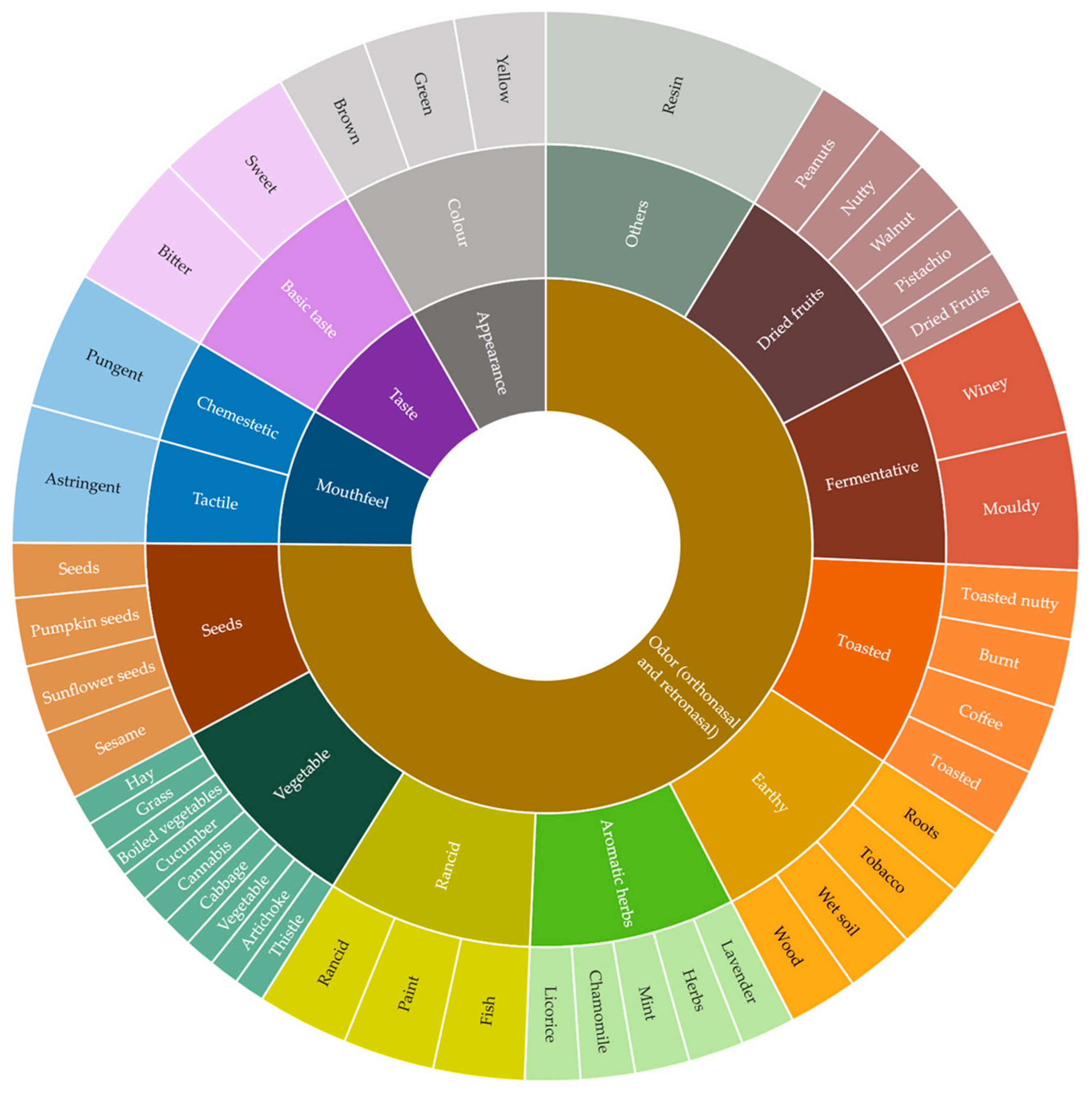
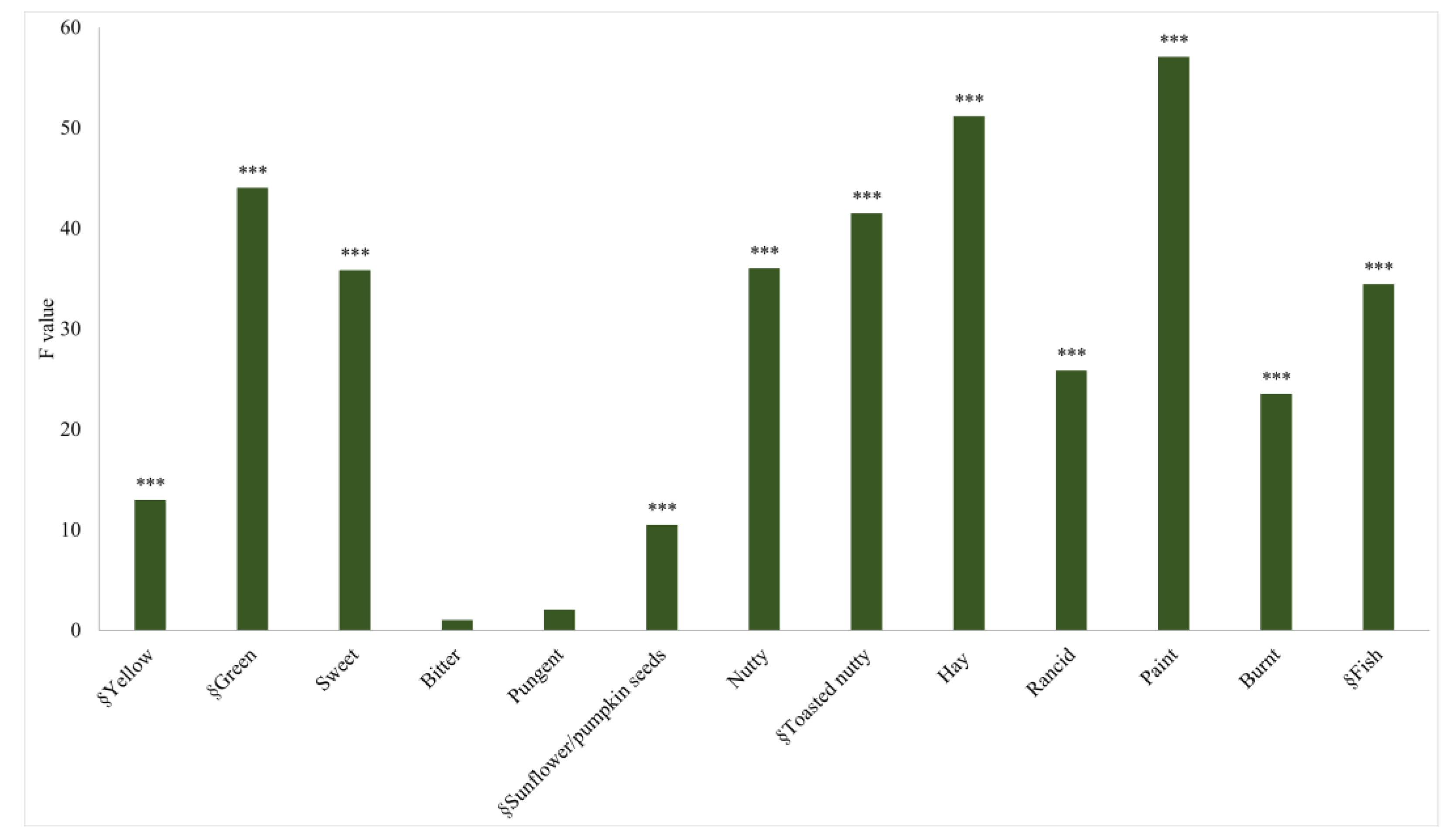
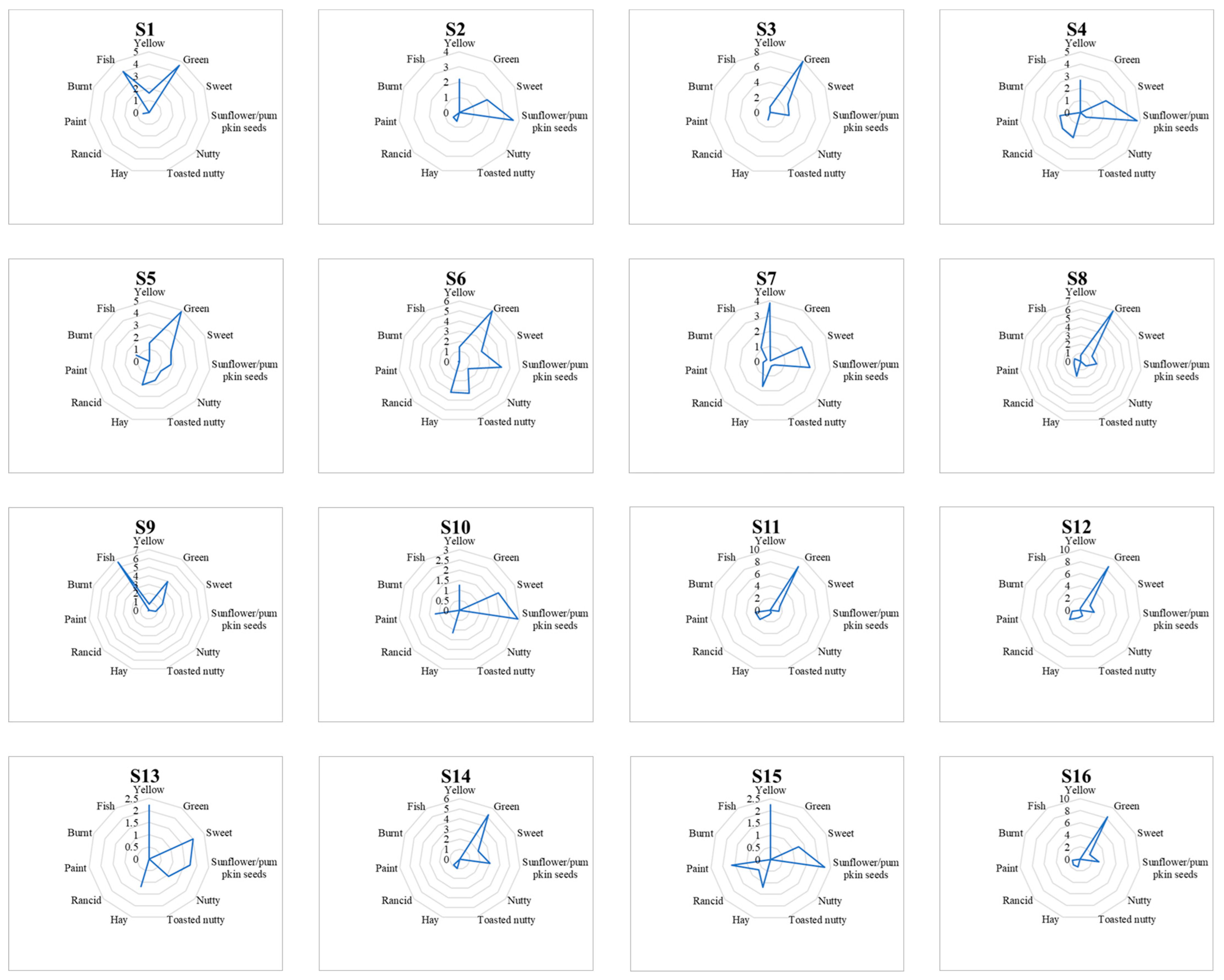
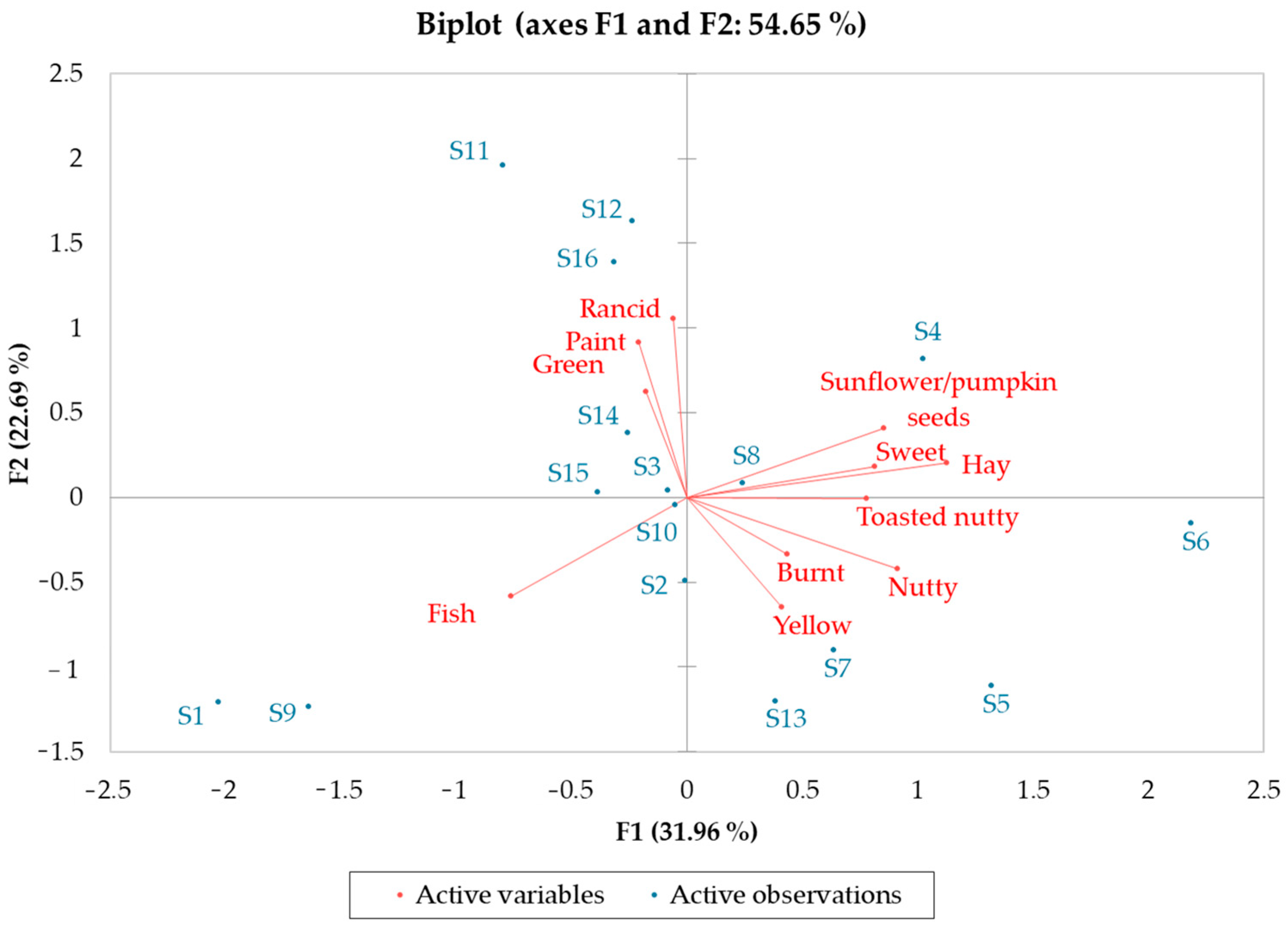
| Attribute | Definition | Standard | Anchor Point (Intensity on a 100 mm Unstructured Scale) |
|---|---|---|---|
| Appearance | |||
| Brown | Intensity of brown color | - | |
| Green | Intensity of green color | A selected cold-pressed hemp seed oil  A selected cold-pressed hemp seed oil  A selected cold-pressed hemp seed oil  | 20/100 60/100 80/100 |
| Yellow | Intensity of yellow color | A selected cold-pressed hemp seed oil  A selected cold-pressed hemp seed oil  A selected cold-pressed hemp seed oil  | 20/100 40/100 80/100 |
| Taste | |||
| Bitter | Taste associated with caffeine, chicory, tonic water [37] | Caffeine 2.0 g/L in water | 50/100 |
| Sweet | Taste associated with sucrose [37] | Sucrose 12.0 g/L in water | 100/100 |
| Mouthfeel | |||
| Astringent | Dryness of the oral surface and tightening and puckering sensation of the mucosa and muscles around the mouth [37] | - | |
| Pungent | Sensation of tingling perceived in the oral cavity [38] | Capsaicin 0.8 mg/kg in water | 100/100 |
| Aroma and flavor | - | ||
| Aromatic herbs | |||
| Camomile | Olfactory sensation of chamomile flower | - | |
| Herbs | Olfactory sensation of aromatic herbs reminiscent of balsamic | - | |
| Lavender | Olfactory sensation of lavender flower | - | |
| Liquorice | Olfactory sensation of liquorice roots | - | |
| Mint | Olfactory sensation of mint leaf | - | |
| Dried fruits | |||
| Dried fruit | Olfactory sensation reminiscent of a mix of dried fruits (i.e., nuts, walnuts, peanuts) | - | |
| Nutty | Olfactory sensation of fresh hazelnuts | 10 g of fresh hazelnut in a disposable glass | 100/100 |
| Peanuts | Olfactory sensation of dried peanuts | - | |
| Pistachio | Olfactory sensation of dried pistachios | - | |
| Walnut | Olfactory sensation of shelled walnuts | - | |
| Earthy | |||
| Roots | Olfactory sensation of earth, soil | - | |
| Tobacco | Olfactory sensation characteristic of dried tobacco | - | |
| Wet soil | Olfactory sensation of oil obtained from seeds that have been collected with earth or mud on them and which have not been cleaned | - | |
| Wood | Olfactory sensation of damp wood | - | |
| Fermentative | |||
| Moldy | Olfactory sensation of oils obtained from seeds in which large numbers of fungi and yeasts have developed as a result of its being stored in humid conditions for several days | - | |
| Winey | Olfactory sensation of certain oils reminiscent of wine | - | |
| Rancid | |||
| Fish | Olfactory sensation of fish oil | 0.5 g/20 mL of fish oil in a disposable glass | 50/100 |
| Paint | Olfactory sensation of paint, siccative oils, linoleum | A selected cold-pressed hemp seed oil subjected to a forced oxidation (Rancimat/Oxidative Stability Instrument, 24 h at 110 °C) in a disposable glass | 100/100 |
| Rancid | Olfactory sensation characteristic of strongly oxidized oils or fats | International Olive Oil Council standard for rancid of olive oil | 90/100 |
| Seeds | |||
| Pumpkin seeds | Olfactory sensation of pumpkin seeds | - | |
| Seeds | Olfactory sensation of seed mixes (pumpkin and sunflower) | Mixture of 50% of pumpkin seeds and 50% of sunflower seeds in a disposable glass | 100/100 |
| Sesame | Olfactory sensation of sesame seeds | - | |
| Sunflower seeds | Olfactory sensation of sunflower seeds | - | |
| Toasted | |||
| Burnt | Olfactory sensation of burnt seeds | Mixture of burnt sunflower seeds, hazelnuts, and pumpkin seeds (cooked in the oven at 200 °C for 1 h) in a disposable glass | 100/100 |
| Coffee | Olfactory sensation characteristic of coffee | ||
| Toasted | Olfactory sensation of toasted note reminiscent of toasted cereals | - | |
| Toasted nutty | Olfactory sensation of toasted hazelnut | Toasted hazelnuts (cooked in the oven at 150 °C for 25 min) in a disposable glass | 100/100 |
| Vegetables | |||
| Artichoke | Olfactory sensation characteristic of artichoke | - | |
| Boiled vegetables | Olfactory sensation of boiled vegetable (such as chicory and savoy cabbage) | - | |
| Cabbage | Olfactory sensation characteristic of boiled cabbage | - | |
| Cannabis | Olfactory sensation characteristic of cannabis plant | - | |
| Cucumber | Flavor produced when an oil is hermetically packed for too long, particularly in tin containers, which is attributed to the formation of 2,6-nonadienal | - | |
| Grass | Olfactory sensation characteristic of freshly mown grass | - | |
| Hay | Olfactory sensation of hay | Dried hay in a disposable glass | 100/100 |
| Thistle | Olfactory sensation characteristic of thistle | - | |
| Vegetable | Olfactory sensation characteristic of fresh broad-leaved vegetables | - | |
| Other | |||
| Resin | Olfactory sensation of natural resin or pine resin | - | |
| Attribute | Frequency of Elicitation (%) | Class |
|---|---|---|
| Brown (V) | 0.7 | Color |
| Dark green (V) | 0.1 | |
| Green (V) | 7.2 | |
| Olive green (V) | 0.4 | |
| Yellow (V) | 8.7 | |
| Bitter1(T) | 5.0 | Basic taste |
| Salty (T) | 0.1 | |
| Sweet1(T) | 6.7 | |
| Astringent 1 (M) | 0.4 | Mouthfeel |
| Pungent1(M) | 5.3 | |
| Chamomile 1 (O) | 0.4 | Aromatic herbs |
| Herbs 1 (O) | 0.6 | |
| Lavender 1 (O) | 0.3 | |
| Liquorice 1 (O) | 0.3 | |
| Mint 1 (O) | 0.1 | |
| Dried fruit 1 (O) | 0.2 | Dried fruits |
| Nutty1(O) | 5.0 | |
| Peanuts 1 (O) | 0.2 | |
| Pistachio 1 (O) | 0.2 | |
| Walnut 1 (O) | 0.1 | |
| Walnut kernel (O) | 0.1 | |
| Roots 2 (O) | 0.1 | Earthy |
| Tobacco 1 (O) | 0.1 | |
| Wet soil 2 (O) | 0.1 | |
| Wood 2 (O) | 0.6 | |
| Esparto (O) | 0.1 | Fermentative |
| Moldy 2 (O) | 1.3 | |
| Winey 2 (O) | 0.2 | |
| Resin 1 (O) | 0.1 | Others |
| Drying oil (O) | 0.3 | Rancid |
| Fish2(O) | 5.2 | |
| Heated (O) | 0.4 | |
| Paint2(O) | 5.1 | |
| Rancid2(O) | 11.0 | |
| Pumpkin seeds 1 (O) | 1.0 | Seeds |
| Seeds1(O) | 5.2 | |
| Sesame 1 (O) | 0.3 | |
| Sunflower seeds 1 (O) | 4.8 | |
| Burnt2(O) | 5.0 | Toasted |
| Coffee 1 (O) | 0.5 | |
| Coffee grounds (O) | 0.1 | |
| Toasted 1 (O) | 1.1 | |
| Toasted nutty1(O) | 5.3 | |
| Toasted seeds (O) | 0.1 | |
| Smoked (O) | 0.1 | |
| Artichoke 1 (O) | 0.1 | Vegetables |
| Boiled vegetables 2 (O) | 0.9 | |
| Cabbage 2 (O) | 0.2 | |
| Cannabis 1 (O) | 0.4 | |
| Cucumber 2 (O) | 0.5 | |
| Fruity (O) | 0.2 | |
| Grass 1 (O) | 1.6 | |
| Hay1(O) | 5.2 | |
| Thistle 1 (O) | 0.8 | |
| Vegetable 1 (O) | 0.5 |
Disclaimer/Publisher’s Note: The statements, opinions and data contained in all publications are solely those of the individual author(s) and contributor(s) and not of MDPI and/or the editor(s). MDPI and/or the editor(s) disclaim responsibility for any injury to people or property resulting from any ideas, methods, instructions or products referred to in the content. |
© 2023 by the authors. Licensee MDPI, Basel, Switzerland. This article is an open access article distributed under the terms and conditions of the Creative Commons Attribution (CC BY) license (https://creativecommons.org/licenses/by/4.0/).
Share and Cite
Tura, M.; Mandrioli, M.; Valli, E.; Dinnella, C.; Gallina Toschi, T. Sensory Wheel and Lexicon for the Description of Cold-Pressed Hemp Seed Oil. Foods 2023, 12, 661. https://doi.org/10.3390/foods12030661
Tura M, Mandrioli M, Valli E, Dinnella C, Gallina Toschi T. Sensory Wheel and Lexicon for the Description of Cold-Pressed Hemp Seed Oil. Foods. 2023; 12(3):661. https://doi.org/10.3390/foods12030661
Chicago/Turabian StyleTura, Matilde, Mara Mandrioli, Enrico Valli, Caterina Dinnella, and Tullia Gallina Toschi. 2023. "Sensory Wheel and Lexicon for the Description of Cold-Pressed Hemp Seed Oil" Foods 12, no. 3: 661. https://doi.org/10.3390/foods12030661
APA StyleTura, M., Mandrioli, M., Valli, E., Dinnella, C., & Gallina Toschi, T. (2023). Sensory Wheel and Lexicon for the Description of Cold-Pressed Hemp Seed Oil. Foods, 12(3), 661. https://doi.org/10.3390/foods12030661




